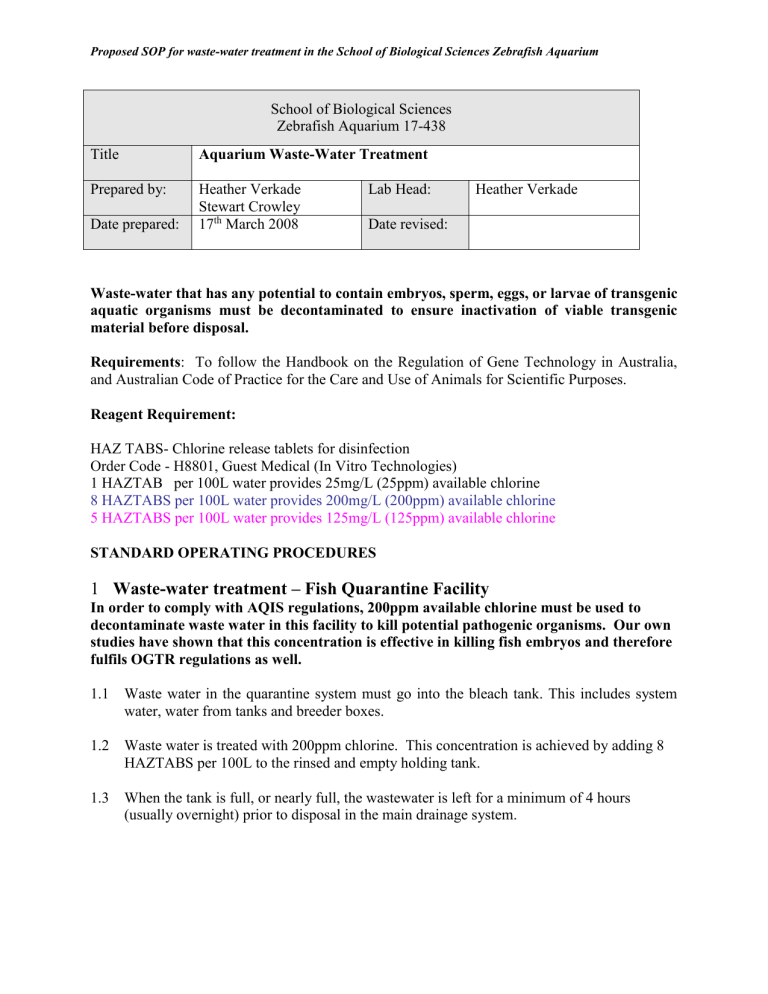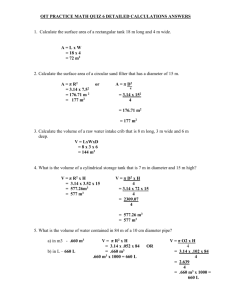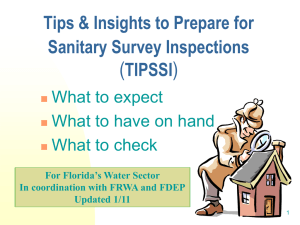standard operating procedures

Proposed SOP for waste-water treatment in the School of Biological Sciences Zebrafish Aquarium
Title
School of Biological Sciences
Zebrafish Aquarium 17-438
Aquarium Waste-Water Treatment
Prepared by: Heather Verkade
Stewart Crowley
Date prepared: 17 th
March 2008
Lab Head:
Date revised:
Heather Verkade
Waste-water that has any potential to contain embryos, sperm, eggs, or larvae of transgenic aquatic organisms must be decontaminated to ensure inactivation of viable transgenic material before disposal.
Requirements : To follow the Handbook on the Regulation of Gene Technology in Australia, and Australian Code of Practice for the Care and Use of Animals for Scientific Purposes.
Reagent Requirement:
HAZ TABS- Chlorine release tablets for disinfection
Order Code - H8801, Guest Medical (In Vitro Technologies)
1 HAZTAB per 100L water provides 25mg/L (25ppm) available chlorine
8 HAZTABS per 100L water provides 200mg/L (200ppm) available chlorine
5 HAZTABS per 100L water provides 125mg/L (125ppm) available chlorine
STANDARD OPERATING PROCEDURES
1
Waste-water treatment – Fish Quarantine Facility
In order to comply with AQIS regulations, 200ppm available chlorine must be used to decontaminate waste water in this facility to kill potential pathogenic organisms. Our own studies have shown that this concentration is effective in killing fish embryos and therefore fulfils OGTR regulations as well.
1.1
Waste water in the quarantine system must go into the bleach tank. This includes system water, water from tanks and breeder boxes.
1.2 Waste water is treated with 200ppm chlorine. This concentration is achieved by adding 8
HAZTABS per 100L to the rinsed and empty holding tank.
1.3 When the tank is full, or nearly full, the wastewater is left for a minimum of 4 hours
(usually overnight) prior to disposal in the main drainage system.
Proposed SOP for waste-water treatment in the School of Biological Sciences Zebrafish Aquarium
2 Waste-water treatment – Main Fish Facility (125ppm available chlorine)
In order to fulfil OGTR regulations, all aquarium waste-water in this facility is decontaminated using a 125ppm available chlorine solution before it is released into the main sewerage system.
2.1
There is a 2-sink system in the Main Aquarium that is clearly labelled. It provides one clearly labelled sink draining into a waste-water holding tank for bleaching. The
2.2
automatic water changes from the system are stored in two alternating tanks for bleach treatment.
Volume of tank
120 L (under sink)
Number of HAZTABs required to treat tanks at current system size
5
Number of HAZTABs required to treat full tanks
(calculated chlorine concentration
= 125ppm)
5
(calculated chlorine concentration
= 125ppm)
200 L (left tank) 5
(calculated chlorine concentration
10*
(calculated chlorine concentration
200 L (right tank)
= 125ppm)
5
(calculated chlorine concentration
= 125ppm)
10*
(calculated chlorine concentration
= 125ppm) = 125ppm)
* Number of haztabs to treat tanks filled to 100L = 5
The system currently drains 100L to the tank per day. In future expansions, more will be drained and the higher doses will be required.
2.2 HAZTABS are added once in the morning to empty, rinsed holding tanks.
2.3 The chlorine treatment record sheet on the tank is completed.
2.4 Treatment time is 4 hours to overnight (usually overnight) before the treated waste-water is drained into the main drainage system.
3 Egg collection
3.1 The water in breeder boxes is poured through an “egg-collection” sieve (tea strainer) to separate the eggs from the tank water. This procedure is carried out in the sink that drains into the waste-water holding tank. The eggs collected in the sieve are then transferred to a Petri dish and incubated at 28 o
C in the incubator in the lab.
3.2 Water from breeder boxes or beakers used to temporarily hold fish or embryos must also go into the sink that drains into the waste-water holding tank.
4 Tank changes
Proposed SOP for waste-water treatment in the School of Biological Sciences Zebrafish Aquarium
4.1 When tanks are removed from the system, the system water from the tank must go into the sink with the waste-water holding tank.







